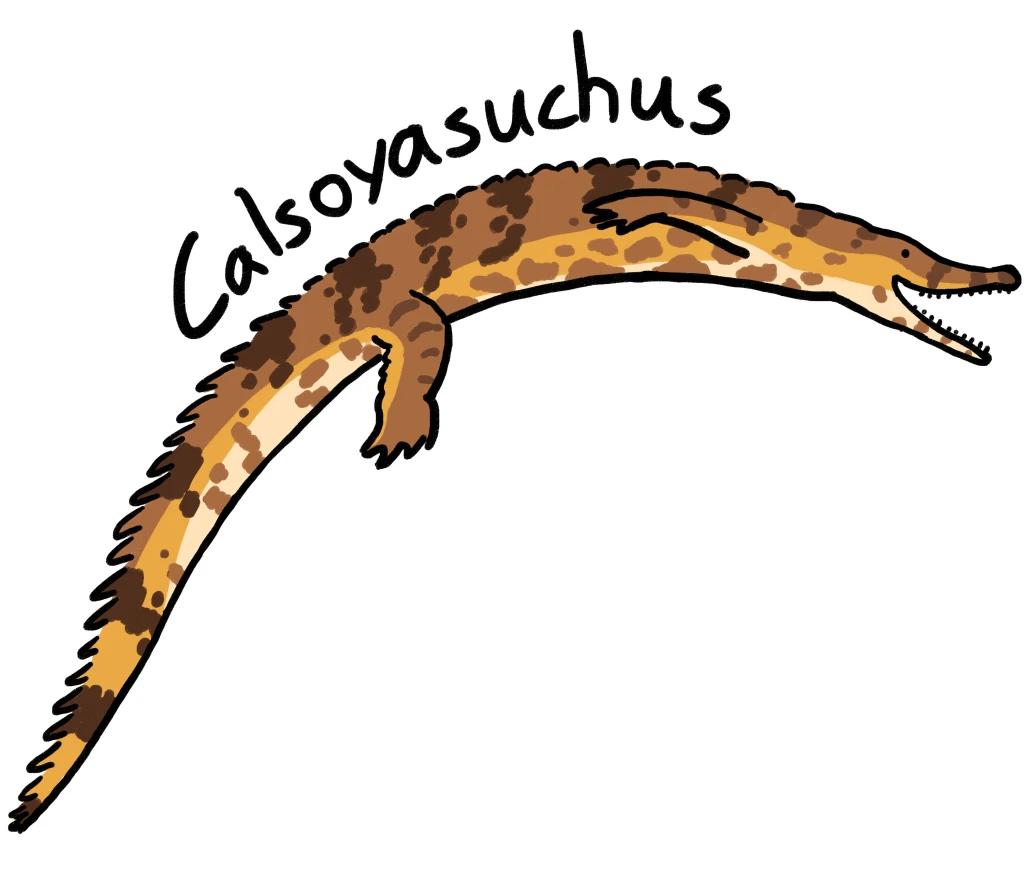
Species: Calsoyasuchus valliceps (Kal-so-ya-soo-kus vah-lee-keps)
What it means: Dr. Calsoyas’ crocodile
Other Species: none

Where I live: Arizona in the U.S.A.- The Kayenta formation
When to find me: The Early Jurassic period, about 196 million years ago.
My favorite food: Fish, turtles, whatever I can catch! I’m a carnivore.

Habitat alongside the many rivers that crisscross the otherwise arid landscape. Mud and silt accumulate from seasonal flooding and sands blowing down from the deserts to the north. Horsetails thrive in places where we might imagine grass and cattails. Ferns, cycadoids, and cycads are the “bushes” of the Jurassic. Ginkgo trees and tree ferns stay close to the water.
My neighborhood: The Kayenta formation used to be a tropical floodplain, a bit like African savannah today- but no grass or flowers. Ferns cover the open plains, dotted with islands of spiky cycad groves. Rivers crisscross the land with lush tree ferns, ginkgo trees, and conifers. Every year during the wet season the plains turn into a flooded marsh, but the hottest months bring no rain, and the rivers shrink until the plains are almost as dry as the great desert that lies to the north.
A few of my neighbors: A lot of dinosaurs come to the river to drink, like the meat-eating Dilophosaurus, Coelophysis, and Kayentavenator, and the plant-eater Sarahsaurus (an early sauropod). They are pretty tough, so I stay out of their way. Little Scutellosaurus (small armored dinosaur) is quite a bit more friendly, and if I’m lucky might even join me for lunch. Mostly I just bask on the riverbank with the frogs, turtles, or fellow crocodile cousins. I’ll often see a long-tailed pterosaur flying overhead for insects like beetles, dragonflies, an ancient cousin of the moth, and something called a snakefly.
Fun Facts:
- I am not a crocodile, but I’m a close relative!
- Paleontologists did a CT scan of my skull, and were able to see all sorts of cool things on the inside, like how much things look like modern crocodiles, which is a bit unusual for a croc-cousin as old as I am.
- The group of animals that includes crocodiles, alligators, caimans, and weird croc-cousins like me is called Crocodylomorpha (croc-oh-dill-oh-morf-ah).
- My genus name- Calsoya honors Dr. Kyrill Calsoyas, former principal of Seba Dalkai Navajo Tribal School, who was very gracious in working with Tykoski et. all + souchos, the Greek form of the Egyptian word for crocodile. My species name is a description of a defining feature of the skull- valles (Latin for valley) + cephale (Greek for head) = valley head.

Fossil Finds:
One partial skull, found lying palate-side up. Though incomplete, and exposed portions of the skull were in poor condition, the rest of the skull was very well preserved.
Resources:
Tykoski, Ronald S.; Rowe, Timothy B.; Ketcham, Richard A.; Colbert, Matthew W. (2002). “Calsoyasuchus valliceps, a new crocodyliform from the Early Jurassic Kayenta Formation of Arizona” (PDF). Journal of Vertebrate Paleontology. http://www.digimorph.org/specimens/calsoyasuchusvalliceps/calsoyas.pdf
Wikipedia was a huge help in knowing where to start when finding research material and basic information.

Ooh, Calsoyasuchus has a really cool-looking skull! It looks a lot longer and narrower than most other croc-cousin skulls. Isn’t it amazing how much we can guess about a critter based on just one part of the skeleton? And who knew there could be so many critters in just one formation! But when you look at the diversity of modern-day wildlife, it makes sense. It’s like–just look at the Okavango Delta!
Oh, and I like the shiny new illustration of the habitat! Must be nice to finally have a tablet again. 😛
LikeLike
Hi Brownie, thank you so much for stopping by!
Hehe, yes, it’s awesome to have my stylus back. It was sorely missed over the week I didn’t have it. Thank goodness for Amazon!
I hope to have more spiffy illustrations of different areas in the Kayenta Formation. Like the Savannah and Desert regions. This is just the riverside. It’s been fun exploring this region a bit better. Scutellosaurus and Dilophosaurus are among my favorite critters, so it’s really cool to be able to imagine their habitat, rather than blank space. You know what I mean? 😀
It’s pretty cool to see how much we can guess from just a few bones, and even more interesting to find out how little is truly known about a lot of these animals. When the defining feature is just a few teeth, that’s a lot of guesswork! The best we can do is look at the best-guess closest relatives and extrapolate a maybe-appearance from there!
Who knows, maybe we’ll find some more Calsoyasuchus fossils in the near future and find out it has some weird proportions for a croc-ish thing that’s a modern-croc-wannabe. lol
LikeLiked by 1 person
I’m glad you showcased this obscure crocodilian. What do you think of it, Patricia? To me, it and some other croc relatives (and the phytosaurs) remind me of gharials.
LikeLike
Hi Angel, it’s good to see you here! 😀
It’s an obscure one, but has special significance for those who study crocodilians. I like how its one preserved feature is a unique and memorable one. Not many critters have a curving snout like that! Critters like this one very much remind me of gharials. In my research on how to best reconstruct the missing body, it seems that it’s closest relatives are a bit gharial-like, so I referenced them for the body. 🙂
LikeLike